Note: The screenshots posted on this page have been scaled up a little from their tiny native resolutions as well as had their aspect ratios corrected to proper 4:3 dimensions as they should have looked on CRT monitors originally. For posterity’s sake you can also click them to view the “pixel perfect” originals.
Introduction
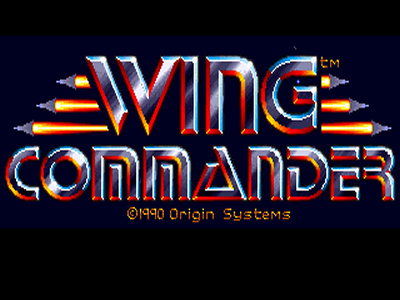
“Wing Commander!”
When I reviewed A-10 Tank Killer v1.5 I mentioned the prominence of flight simulators in 80s and 90s PC gaming scene, and I don’t think you can talk about classic PC fight sims without bringing up what surely has to be one of the most influential and impactful PC game series ever: Origin’s Wing Commander, which kicked off in 1990.
When I got my shiny new 486 in 1993 Wing Commander was one of those games whose reputation preceded it. Even as someone who didn’t own any sort of machine capable of playing anything even close to semi-modern and who didn’t follow the personal computer scene all that closely besides, I had heard the name and knew that it was supposed to be something amazing. Cobbling together enough money to buy a used copy of it from a shady used PC game trader from the back of a gaming magazine I finally got to see what all of the fuss was about…
A lot of fuss there was, too! While I feel like Wing Commander is still a well-known franchise, despite not having a new release in something like 15 years now, I wonder how many current gamers really get why. It cannot be understated: when Wing Commander was released in 1990 it absolutely BLEW PEOPLE AWAY. Origin somehow took a bunch of the latest and emerging tech and even some innovations of its own and put them together in a single highly polished package the likes of which hadn’t really ever been seen before. The game included features such as unique 2.5D style scaling-sprite based VGA graphics, a full, highly branching storyline, cinematic cutscenes before that was really a thing, character progression, NPC deaths that actually impacted your gameplay, nifty in-game-world menus, and a dynamic music system with awesome, state of the art Roland pre-MIDI music and effects. This was next level stuff, and not just for flight sims, but for PC games period.
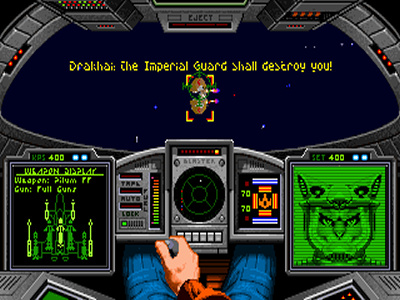
“Also, we have funny hats!”
So how’d it go for me? Well unfortunately even though I owned a copy of the game when it was still relatively new and I was of the perfect age and mindset for it, Wing Commander consistently failed to ever sink its hooks into me. I think a big part of that was that I had already been spoiled by the amazingly smooth gameplay experiences of early first person shooters like Wolfenstein 3D and Doom, which used similar “sprite scaling in 3D environments” graphical techniques, and Wing Commander’s engine never felt quite as fast or smooth as those later games, nor did that method of rendering an environment seem to work quite as well in a space game with such a higher degree of freedom of movement. That, and having tried the game a few more times in more recent years I discovered just how sensitive the first Wing Commander game was to timing issues, and I suspect that my 486 probably ran the game fast enough to cause me serious timing problems that I was completely oblivious to at the time – in fact I recall the numerous asteroid field and space mine sections being much more deadly than they are to me nowadays despite my strategy for getting through having never really developed significantly in the last 20+ years.
Much more on all of that technical stuff later though – let’s dig into the game play.
Gameplay
You start the campaign off by losing a round in a combat simulator and stepping out into your ship’s bar, but an adventure game this is not! Instead, these in-between mission sections of the game are represented by a creatively put together in-game-world menu system where most of the game’s options are represented by interacting with objects in the game world. For instance, to save your game you need to click the door to the barracks and click on a bunk. Each bunk represents a different save slot, with occupied save slots represented by occupied bunks. Personally, I love these types of systems and while they were popular in early PC gaming (and have resurfaced mostly prominently in recent years in Starcraft II: Wings of Liberty) few games took it as far or handled it as consistently as Wing Commander.
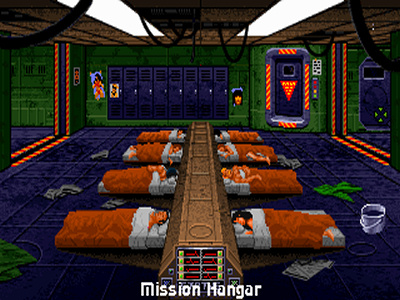
“The Tiger Claw’s infamous co-ed locker room.”
From these menus you have the option of talking to some of the NPCs on your ship to learn tips and hear rumors about the campaign (again, this isn’t an adventure game – these are really just non-interactive cutscenes) viewing your score and commendations, saving and loading your game and, when you’re ready, seeing the briefing for your next mission (again, a non-interactive cutscene) before jumping in your fighter and taking off. In fact, that’s really all there is to the basic flow of the in-between mission game play. While there’s admittedly little to do in this section of the game it is still chock full of atmosphere and helps a lot with immersing you into life as a pilot aboard a carrier ship in the midst of a dangerous conflict. The meat of the game though is, of course, the missions themselves.
After an exciting (and at the time, kind of mind-blowing) takeoff cutscene you’re thrust into a stereotypical first person flight simulator style view of your fighter’s cockpit from which you can view various instruments and indicators representing the operation of your fighter including weapon selection, armor and shield status, target status, a mini-map, and a targeting HUD as you bob along outside of your carrier. You can also see your fighter from other views and camera angles too which, while neat, is mostly useless as the game was obviously developed with the default first person cockpit view in mind and it seems to work the best that way even for those who might prefer a 3rd person view.
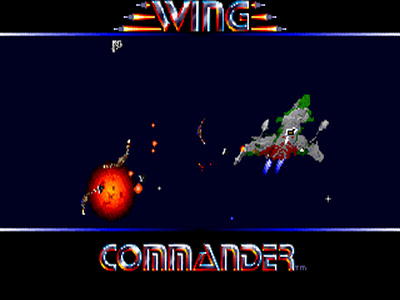
“The “battle camera” view of a particularly hairy dogfight.”
There are a few canned types of missions such as patrols, escort missions, and strikes against specific targets. In reality though no matter the mission type you’ll usually be tasked with just going to a series of waypoints and dealing with whatever obstacles happen to be there or interrupt you along the way which typically means a group of enemy ships, sometimes even multiple waves of them, but there’s also sometimes the aforementioned asteroid and mine fields you have to navigate through as well. And hey, sometimes there’s both! They’ll be some occasional talking head popups confirming orders from your wingmen or showing you taunts from Kilrathi pilots but for the most part there’s no real exposition during the missions and things more or less stick to the plan laid out in the briefing.
Thankfully Wing Commander is very respectful of the player’s time and lets you autopilot between waypoints, warping you almost directly between them. After you visit all of the waypoints and/or beat any other specific objectives you might have, you then fly back to your ship and land. I’m so grateful that landing is an automated process as I can imagine a manual landing into the Tiger’s Claw landing bays being a total pain in the ass if the numerous times I managed to fuck up the simple auto-landing process is anything to go by.

“Another unsuccessful attempt to line up a landing…”
As you might have guessed by the fact that you’re not forced to make a tense landing after every mission nor endure 10 minutes of monotonous travel between waypoints, the controls and flight model, while certainly more complicated than arcade flight combat games, are both relatively simple and fairly forgiving compared to more hardcore flight simulators. Indeed, while there is 360 degrees of movement, Chris Roberts and company were obviously influenced by the Star Wars approach of “World War II dogfights in space” physics and combat. Often times combat comes down to two fighters just making strafing passes at each other. That’s basically it. There’s no sub-system targeting, missile weapons are extremely limited and aren’t as strong as you might hope for, and there’s not much else to combat than trying to shake enemies off your tail while you try to get on theirs. Of course, as an intelligent player you certainly have options for adding a little more in the way of tactics and finesse to your dogfighting than your opponents do, if you choose. Personally, I’m rather fond of using my afterburners to zip past and get behind my targets or to jet away from them to let my weapons recharge, for instance.
That’s one of the trickier parts of the early game – getting used to managing your fighter’s weapon and shield power. It doesn’t help that the game starts you off with what is, in my opinion, by far the worst ship in the game. As soon as I graduated to the next tier of fighter (with its heavier armor and better weapon loadout) the combat got quite a bit easier and I actually really started to enjoy myself. In reflection I have to wonder if I ever actually got past those early Hornet missions back in ‘93 – that could explain a lot! Still, learning how to fly and having a ship worth flying is only part of it.
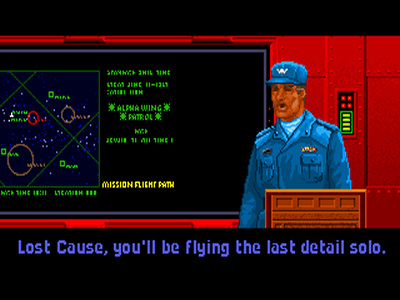
“Why not? It’s not like we’re on a carrier full of fighters or anything…”
While enemy AI shows some interesting behavior at times (with the Secret Missions 2: Crusade expansion even totally overhauling them) and the different types of enemy ships and pilots (including occasional appearances by enemy ace pilots) employing their own tactics and levels of skill, the real challenge in Wing Commander comes almost entirely from the increasing numbers of enemy ships in each mission as the game progresses. The damage model (which seems fairly developed, allowing for specific fighter systems to be damaged and for some to even auto-repair themselves over time, and at the same time allows for just a few unlucky shots to ruin your day) combined with these often incredibly stacked odds later on makes for a challenging and admittedly fairly frustrating game at times. So you can win a 1 on 1 fight 100% of the time? How about 6 on 1? You survived that? How about you do it 3 more times this mission? It feels a little artificial to always be so outnumbered and frankly it gets a little old. I know our character is supposed to be some sort of awesome ace pilot but if you suspect a massive Kilrathi death armada is in the system maybe you should dispatch more than two fighters to go take them down? Just an idea! It’s not just the repetition, even the most skilled players will have to struggle against shield and fuel attrition to make it through some of the harder missions.
You’re not alone out there, of course. You’re typically assigned a single wingman who will follow you around and sometimes annoy you by flying into your line of fire or just generally being a nuisance. Other times you’ll realize they’re nowhere to be found and wonder if they got blown away without you noticing. You can give them a few basic orders but for a title called “Wing Commander” this aspect doesn’t seem to be as reflected in the gameplay as some might hope. Instead your wingmen are largely useless save their ability to occupy one or two enemy fighters until you can finish off the ones you’re fighting. Throughout my playthrough they only really affected me if they somehow managed to get themselves killed causing me to have to consider restarting the mission. That’s because, awesomely, your wingmen NPC’s deaths are permanent and most definitely noticeable: you might have to fly a whole series of missions solo and there will be an empty chair in the bar where the game otherwise intended you to be able to chat with them during certain sections. I admit I felt like a real asshole whenever I let one die.
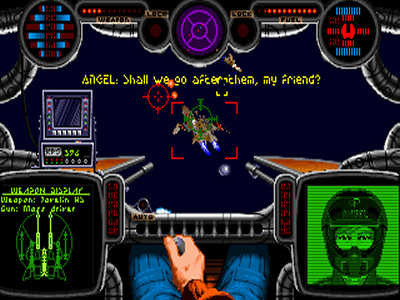
“Lining up for the kill on a Gratha… no thanks to my wingman.”
After the mission you’re shown another cutscene depicting your debriefing and, if you got lucky and performed particularly well, an awards ceremony and/or promotion and then you’re shot back into the ship’s bar to prepare for the next mission. That is, in a nutshell, the game.
I can’t end this section without talking a bit about one of the more interesting features of Wing Commander’s gameplay: the single player campaign’s branching structure. You see, after you do a few missions, depending on how well you did, you succeed or you fail that star system, with each condition sending you to a different system and set of corresponding missions to continue the campaign. The complicated lattice structure that develops from this pass/fail system allows for different playthroughs to consist of largely different missions and events, ultimately leading to a final campaign to win the game or a desperate retreat away from the conflict. While I love the idea of this sort of dynamic campaign structure it does seem like the winning path is typically a bit easier and certainly less bleak, and who likes getting kicked while they’re already down, really?
For better or for worse the two expansion packs, Secret Missions and Secret Missions 2: Crusade largely abandon this branching structure with their new campaigns, though they do at least still allow you to lose at certain points during their campaigns, directing you play through a unique retreat scenario before the game ends proper. Still pretty cool!
Story
You’re an unnamed Terran Confederation starfighter pilot newly assigned to the Tiger’s Claw carrier amidst a vicious war against a race of bloodthirsty, feline-like aliens called the Kilrathi. While the NPCs are almost entirely made up of ridiculous caricatures (Spirit in particular is just… remarkable) the ship designs, the silly-but-somehow-still-kind-of-cool Kilrathi, and many of the other elements of the gameworld are actually very well done and really only seem to get cooler as the series progresses. Still, for a game that does such a great job with immersing the player into the life of a space pilot and was obviously so influenced by the tropes of space operas, all of it really does very little in the service of telling an actual story. Your learn a bit about your enemies, about the conflict itself, and of course about your fellow pilots (some of which is fleshed out in the excellent “Claw Marks” manual) but as far as a plot? Well, the game ends with the Confederation either seemingly slowly but surely losing the war, or striking a decisive blow that should set them up for winning it. That’s about it.
When compared to later games in the series it is obvious that the lack of drama in the first Wing Commander is a trade-off for the more dynamic, immersive nature of some of the systems I just spent numerous paragraphs gushing over: naming your own pilot, receiving commendations and promotions based on performance, the insanely branching mission tree, the ability to lose your wingmen? None of that would be very easy to pull off with a heavily scripted narrative.
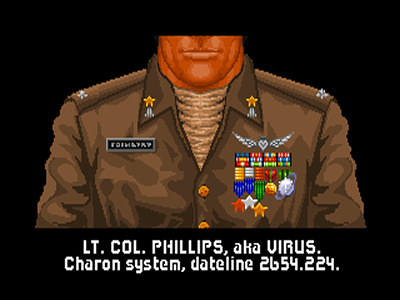
“Not much character development but… ooh, shiny!”
The two expansion packs, Secret Missions and Secret Missions 2: Crusade improve the story telling a little, probably mostly out of necessity. After all, “Errr, well the war is still going on… so here’s some more missions!” isn’t a very compelling premise for a paid expansion, is it? SM2 goes the farthest into righting some of these wrongs by adding some new twists including new enemies with more interesting motives, new allies, a new ship to fly, an NPC death, and two new wingman NPCs joining your crew. Really, quite a lot for a simple mission pack, and helping bridge the gap between the stories of Wing Commander and Wing Commander II at that. As mentioned the mission tree takes a hit in both expansions but, again, trade-offs, right?
Controls
Again, while this is a flight simulator, it’s a fairly basic one. There are a slew of keyboard controls but relatively few of them with most being unneeded for basic play. Take offs and landings are automatic, navigation is simple and handled by an ever present waypoint system, wingman and enemy communication is limited and simple, etc. I would chalk this up to smart design more than attempt to dumb the game down, personally.
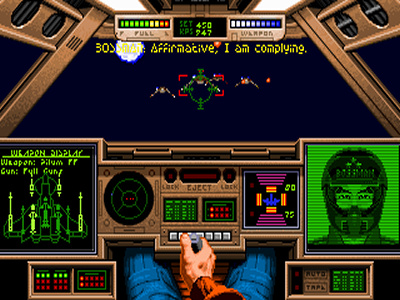
“Charging in head first but sending my wingman to flank.”
I played the game with a joystick as my primary input device which I’d highly recommend. I used an old fashion two button flightstick with my keyboard backing me up most of the time but I’m sure you could map a more advanced stick to have pretty much every keyboard button you’d need on your stick instead. Honestly I’ve always found the joystick controls in Wing Commander to be a little twitchy and inaccurate but “feel” aside, the game doesn’t really require much precision in the first place. Hit boxes on enemy ships seem relatively large meaning they’re easy to hit, ranges on your guns are fairly short meaning you’ll be fighting in close quarters most of the time anyway, and auto-locks for missiles certainly help a bit too. You probably won’t want to try for flying accuracy either, as the aforementioned huge hit boxes make fancy flying moves disappointingly difficult to pull off with anything resembling finesse.
Graphics
This is one of the areas where this game truly shined in 1990. Beautiful 256 color VGA with an interesting style that absolutely screams early 90s personal computer game. While I’m sure that style won’t appeal to a lot of people I have no real complaints about the art itself. There’s all kinds of interesting little touches, cool animations and effects, and heaps of attention to detail and general polish that make the graphical presentation of Wing Commander feel triple A all the way and in many instances still look good today.
The engine is quite interesting in itself. At the time most flight simulators were using extremely rudimentary 3D engines. These had a lot of advantages (many of which probably weren’t as obvious then as they are nowadays) but they were relatively ugly. Wing Commander was one of first games (if not the very first?) to use the “2.5D” style of 3D, using sprites of multiple different angles of an object and some creative scaling to emulate 3D objects moving in space, giving the appearance of fully textured 3D objects well before that technology was accessible on home computers. id Software later popularized this technique with Wolfenstein 3D and Doom before kicking real 3D engines (now with actual bitmapped textures!) into popularity with Quake. Apparently Wing Commander’s tech was what inspired id Software original FPS work, even. Let that sink in!
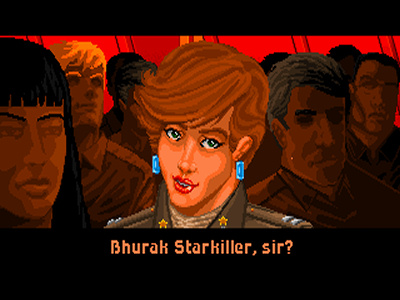
“Angel looks suspiciously intrigued.”
It’s not all roses though. As I mentioned in the introduction, the low frame rate, the way sprite scaling works, and the way objects rotate (which is exasperated by the 360 degree freedom of movement Wing Commander offers, unlike the limited perspective offered by something like Doom) add together to make space combat feel a little… clunky?
More than affecting my perception there were many times where it actually affected gameplay: there’s nothing like approaching an enemy destroyer for a strafing run only to find that it has suddenly swung its bow around just in time for you to smash headlong into it, doing massive damage to your fighter and stopping you dead in your tracks. If this had been using a decent 3D engine you could have seen the gradual movement of the ship’s model as it was turning but here in Wing Commander it’s just an instant change from one angle sprite to the next. This happens more than you’d think it would – I already mentioned all of my Tiger Claw auto-landing mishaps, right? And the lack of precision flying because of the huge hit boxes? These things all add up to make flying a whole lot less exciting than it could be, as later demonstrated masterfully by LucasArts’s Star Wars: X-Wing series.
Sound
Like with its graphics, Origin went the extra mile with the technology of Wing Commander’s sounds, particularly its music. It’s an interesting snapshot of the time when Roland’s pre-General MIDI MT-32/LAPC sound was emerging as an incredibly impressive advancement, and Wing Commander even relied on it for sound effects instead of using digitized effects (Sound Blaster was just starting to gain popularity at this point, after all.) If you don’t have (or emulate) an MT-32 then the Adlib does a respectable impression of the soundtrack and sound effects too, with the added bonus of sounding all… Adlib-y. That said, the effects themselves aren’t particularly impressive. Eh, they get the job done for the most part.
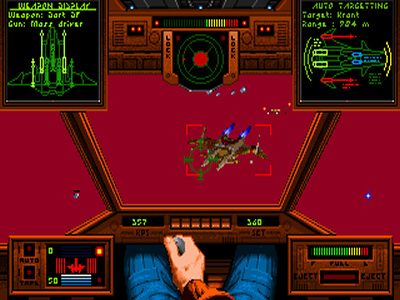
“Seeing red…”
Back to the music though. The main theme and in-flight orchestral music is probably the most well known of all of Wing Commander’s soundtrack though I personally find myself enjoying some of the more subtle tracks in the in-between mission sections more. Hats off to the composers. The in-flight music is definitely the more notable though, as it uses a dynamic system to somewhat seamlessly shift to more intense music when an enemy appears and other events occur. While Origin’s system was surely overshadowed by the impressive LucasArts developed iMUSE system it’s certainly another interesting example of Wing Commander helping to lead the way technologically.
Old Age and Alternative Versions
I played through Wing Commander and both of its “Secret Missions” expansions on my dedicated gaming 486DX PC which was more than adequate to handle the game. In fact, as mentioned in the introduction, the game suffers from some rather extreme speed issues on newer machines. These were gradually fixed as the use of this engine continued over the years. For instance, Secret Missions 2, which apparently uses a precursor to Wing Commander II’s version of the engine, seems to run a little smoother and be less sensitive to the system clock and Wing Commander II itself is an even greater improvement. Still, the first Wing Commander needs to be handled with some serious kid gloves if you want to stand any chance of doing well enough to beat it. This shouldn’t be a huge shock when you remember that despite it’s VGA graphics and other typical mid-90s trappings, this game was released all the way back in 1990 and was probably aimed at no more than 386 machines. It simply doesn’t know what to do with the sheer power of a 486 or Pentium processor. Thankfully using my usual trick of disabling my CPU’s internal cache slows it down to buttery smooth 386 speeds.
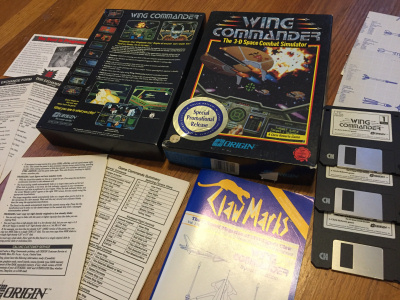
“I still have my original copy complete in box.”
A better option for most people is going to be DOSBox. I did a fair amount of testing Wing Commander in DOSBox and concluded that, despite a little artificial choppiness here and there compared to running on legit 90s hardware the game runs quite well. Couple that with the usual advantages of being able to use advanced scalars and higher resolutions, as well as being able to easily map all of the controls to your favorite, fancy 300 button USB HOTAS setup, it’s easy to recommend. That, and you can get a legal copy of the game and both mission packs (which used to be somewhat rare!) coupled with the sequel and its own mission packs pre-packaged with DOSBox on GOG.COM for a reasonable price. Awesome.
Wing Commander was also one of those classic PC games that was ported to almost everything with any sort of popularity at the time and, surprisingly, this mostly includes game consoles. It’s not worth going into the subtle differences between the DOS, Amiga, and FM Towns ports, for instance, but here are a few of the more interesting ones:
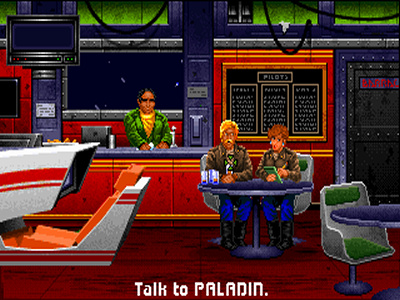
“The Tiger’s Claw bar – PC”
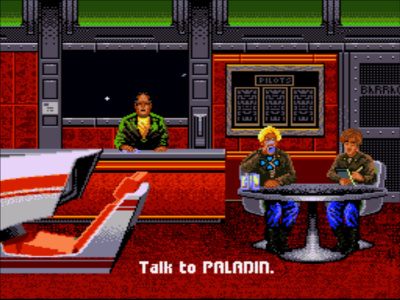
“The Tiger’s Claw bar – SNES”
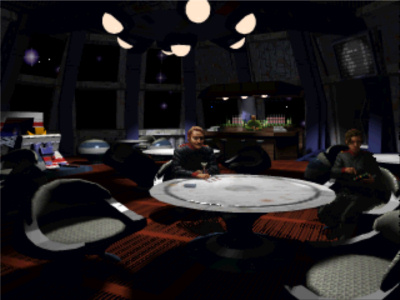
“The Tiger’s Claw bar – 3DO”
Starting on the low end, believe it or not Wing Commander and, separately, the first Secret Missions campaign, were released for Super Nintendo Entertainment System. This version sports some drastic differences given the much lower resolution and limited color palette along with the memory limitations of the system – redrawn sprites for many screens, different cockpits, etc. That, and Nintendo made a variety of bizarre changes in the name of censorship. So it goes. Control wise the SNES version somehow manages to cram the most important keys onto the face of the joypad without too much trouble and given that the game was never super-smooth in the first place it doesn’t suffer too badly from being played with the system’s digital pad. All in all I was actually surprised at how well this version plays relative to the DOS original despite the limitations. Still, it does do some kind of funky things with limiting how many sprites are ever on the screen at once and making it so only one enemy is attackable at a time. Oh, and also no saved games! Humph.
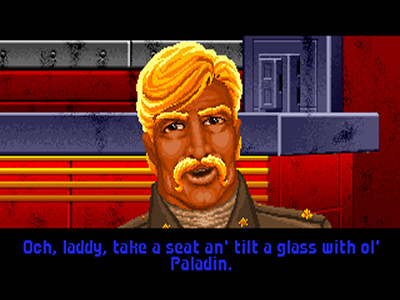
“Talking to Paladin – PC”
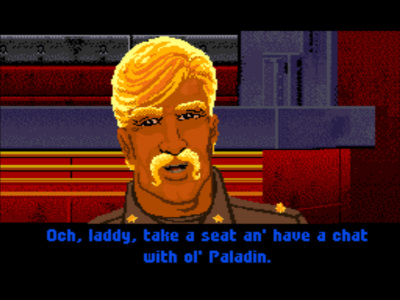
“Talking to Paladin – SNES”
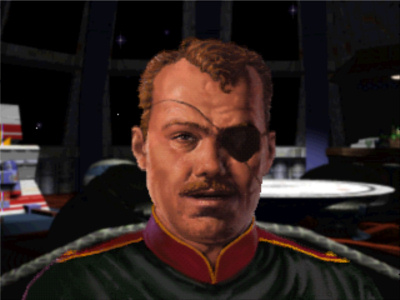
“Talking to Paladin – 3DO”
Next up is the Sega CD port released in 1992. At a glance this version looks almost identical to the original PC release, the system’s smaller color palette aside (which is why its not pictured here, by the way.) This biggest difference in the presentation is the audio. Behold, this version is fully voiced! While I couldn’t describe the voice acting as “good” it is average 90s game voice acting which is at least adequate and honestly matches to tone of the game’s dialog pretty well. I can’t really recommend the Sega CD version, however. First, like most Sega CD games there is some considerable loading between screens and, more troubling, general, fairly consistent slowdown in the missions themselves, similar to that experienced on the PC when there is a whole lot on the screen at one time. They were obviously really struggling with system resources when they ported this one – the sprites are also noticeably lower quality than other versions. It’s not terrible but both issues certainly take away from the experience. Worse are the controls – unlike the SNES port, the Sega CD version has you struggling with an unintuitive selection of button and direction pad combinations for even some of the more basic actions. Ugh.
Finally, we have 1994’s “Super Wing Commander” released on 3DO and later MacOS (I tried out the 3DO version.) Bizarrely, this version completely overhauled every aspect of the audio and video presentation of the original game while keeping the original gameplay more or less perfectly intact. The graphics have this gritty, semi-realistic painted look to them that looks very cool in my opinion. I kind of wish this wasn’t an evolutionary dead end for the series, as the closest other games in the series ever got to looking like this was probably 1993’s Privateer. Not only were the graphics a completely different style, but the basic designs of everything, and I mean EVERYTHING, from the characters to the ships themselves, were totally different. For this reason most hardcore Wing Commander fans pretty much loath this version. While I like a lot it myself, I’ve got to admit that the new cockpits are pretty damn ugly and I would have rather just seen new depictions of the old designs done in this new style. A bigger sin to me are the rare moments when the game breaks out of in-engine cutscenes to switch to terrible pre-rendered CGI. I know CGI was really in vogue at the time, especially with CDROM titles, but these really should have been left on the cutting room floor.
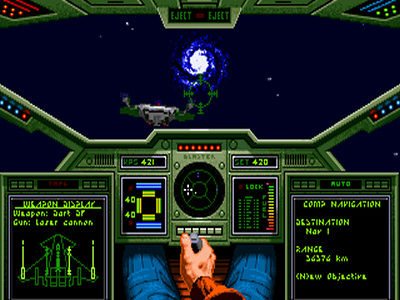
“Rapier facing the Tiger’s Claw – PC”
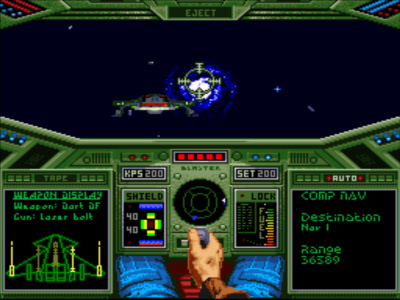
“Rapier facing the Tiger’s Claw – SNES”
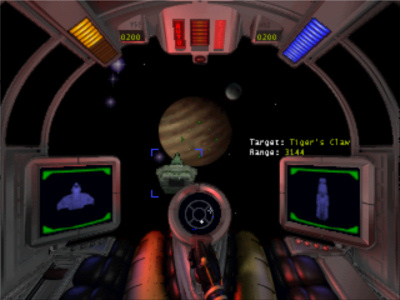
“Rapier facing the Tiger’s Claw – 3DO”
The voice acting for Super Wing Commander is totally different than the Sega CD version as well, not necessarily better or worse, just different. Still likeable in a “terrible mid-90s FMV game” sort of way although most people seem to prefer the ones from the Sega CD version. The biggest compliment that I can pay this version is that it looks and plays incredibly smoothly when it comes to space combat itself – the ship and other space object sprites seem to be higher resolution and scale a lot better and the framerate feels higher and more responsive than virtually all of the other versions I tried. Still, it also suffers from the same terrible control issues as the Sega CD port – too many keys but not enough buttons on the 3DO’s joypad to easily map them too. I suppose if you got creative with a macro program you could mimic the PC version’s controls while playing via an emulator but playing this on an actual 3DO in the 90s much have sucked. Interestingly Super Wing Commander contains both of the Secret Missions campaigns and even some unique bonus missions (often referred to as Secret Missions 1.5 due to falling between the other two expansion packs in the timeline of the series.)
Divisive as it might be, of all of the console versions this would without a doubt be my desert island pick… as long as I had a map of the ridiculous controls to reference.
As for the documentation, this game’s lauded “Claw Marks” manual and the other “feelies” included (ship blueprints, mainly) come in PDF format with any legit version of the game. Reading it isn’t required (but is useful for getting around the copy protect if your version has it!) but is highly recommended due to the large amount of additional game fiction and other information (including combat tactic hints, details about technical specifics of Confed AND Kilrathi ships, etc.) it presents. Due to Wing Commander’s active fanbase this documentation, along with other fan compiled information and FAQs, is also readily available at innumerable sites online without too much searching. The excellent Wing Commander CIC fan community is a great starting point.
Sequels and Related Games
Not too long after the release of the Secret Missions 2 expansion in 1991 Wing Commander II: Vengeance of the Kilrathi was released. More on exactly what that brought to the table in a future review, I hope. The famously free roaming take on the formula, Wing Commander: Privateer was released in 1993 just before the highly praised full motion video juggernauts Wing Commander III: Heart of the Tiger and Wing Commander IV: The Price of Freedom were released in 1994 and 1996 respectively. There were a few more spin offs and sequels along the way too, such as Wing Commander: Academy and Wing Commander: Armada, and of course the last proper game of the series, 1997’s Wing Commander: Prophecy. Again, I hope to touch on these games in much more detail in future reviews.
Origin also released Strike Commander, Pacific Strike, and Wings of Glory in the mid 90s which are directly related to the engine and gameplay of Wing Commander, Chris Roberts being heavily involved in the first. Outside of Origin Systems, there were Starlancer and Freelancer, which Chris Roberts was directly involved in and were certainly a continuation of some of the themes and gameplay of the Wing Commander series. Then there’s the currently in-production Star Citizen which has certainly been causing waves if nothing else.
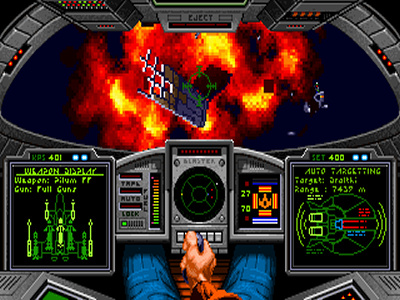
“What victory looks like up close.”
I feel comfortable saying that virtually every other game in the space flight combat genre has been influenced by Wing Commander and its successors. You really need look no further than the homebrew and modding communities to see just how influential the Wing Commander series was to many of us. There are an incredible amount of unofficial Wing Commander games and total conversion mods for other engines out there and the list continues to grow. Still, as almost all of these are more influenced by the mechanics and presentation of later games in the series I don’t think I’ll go into detail on any particular one of these here. Impressive, though, no doubt.
Closing
Wing Commander was an extremely important game in the history of PC gaming and marks an intriguing intersection between the simulator inspired mechanics of older, more niche computer games and the slick audio and video presentation that would become the norm in modern gaming. While it’s aged relatively well in most respects it’s probably only worth going back to if you’re comfortable with what you’re getting into when you launch off of the Tiger’s Claw: not much in the way of story, repetitive, often unfair missions, and less than stellar flying. Otherwise, later games in the series and other, later space flight combat games borrowed extensively from this game and built upon its shortcomings, making for surely more entertaining visits to the past. Even so, it would be very easy to justify Wing Commander’s place in the 1990s PC gaming time capsule as an absolute classic.
I always do a ridiculous amount of research when I do a retro review and I chuckled quite a bit from this tidbit of a review of Wing Commander from the UK’s PC Plus magazine: “Combat is resolved by locking into the target, centring a cross in the Head Up Display (HUD) crosshairs, then engaging the autopilot.” Ha! While the game doesn’t allow you to autopilot away when there are enemies around, if you could I can’t imagine that strategy would win you too many gold stars…